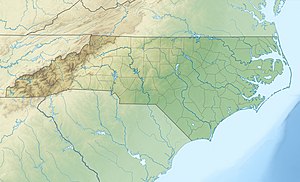Pigeon House Branch
| Pigeon House Branch Tributary to Crabtree Creek | |
|---|---|
| Location | |
| Country | United States |
| State | North Carolina |
| County | Wake |
| City | Raleigh |
| Physical characteristics | |
| Source | divide between Pigeon House Branch and Rocky Branch |
| • location | Raleigh, North Carolina |
| • coordinates | 35°47′20″N 078°38′40″W / 35.78889°N 78.64444°W[1] |
| • elevation | 280 ft (85 m) |
| Mouth | Crabtree Creek |
• location | Raleigh, North Carolina |
• coordinates | 35°48′16″N 078°36′32″W / 35.80444°N 78.60889°W[1] |
• elevation | 190 ft (58 m)[1] |
| Length | 2.88 mi (4.63 km)[2] |
| Basin size | 4.69 square miles (12.1 km2)[3] |
| Discharge | |
| • location | Crabtree Creek |
| • average | 5.29 cu ft/s (0.150 m3/s) at mouth with Crabtree Creek[3] |
| Basin features | |
| Progression | Crabtree Creek → Neuse River → Pamlico Sound → Atlantic Ocean |
| River system | Neuse River |
| Tributaries | |
| • right | Cemetery Branch |
| Bridges | Wade Avenue, US 1/401, Old Louisburg Road, Crabtree Boulevard |
Pigeon House Branch is a 2.88 mi (4.63 km) long tributary to Crabtree Creek in Wake County, North Carolina and is classed as a 2nd order stream on the EPA waters geoviewer site.[3]
Course
[edit]Pigeon House Branch rises in downtown Raleigh, North Carolina then flows northeast to meet Crabtree Creek just upstream of Bridges Branch. It is one of the more developed tributaries with less than 1% of the watershed considered to be forested.
Watershed
[edit]Pigeon House Branch drains 4.69 square miles (12.1 km2) of area that is underlaid by Raleigh Gneiss geology.[4] The watershed receives an average of 46.7 in/year of precipitation and has a wetness index of 433.76.[3]
See also
[edit]References
[edit]- ^ a b c "GNIS Detail - Pigeon House Branch". geonames.usgs.gov. US Geological Survey. Retrieved September 14, 2019.
- ^ "ArcGIS Web Application". epa.maps.arcgis.com. US EPA. Retrieved September 14, 2019.
- ^ a b c d "Pigeon House Branch Watershed Report". Waters Geoviewer. US EPA. Retrieved September 14, 2019.
- ^ "Wake County Geologic Map". www.arcgis.com. North Carolina Geological Survey. Retrieved September 18, 2019.


 French
French Deutsch
Deutsch
